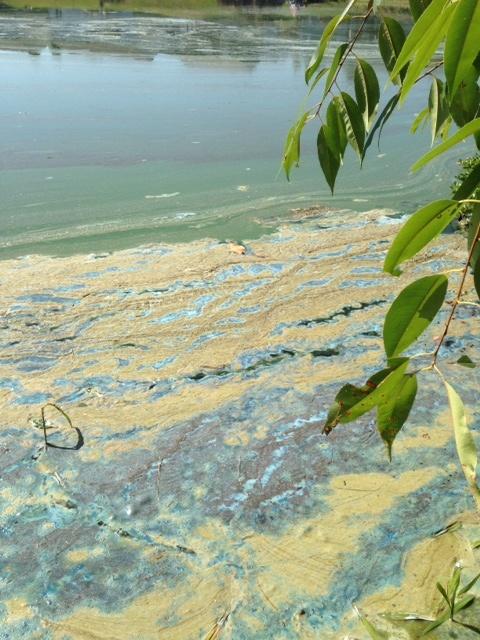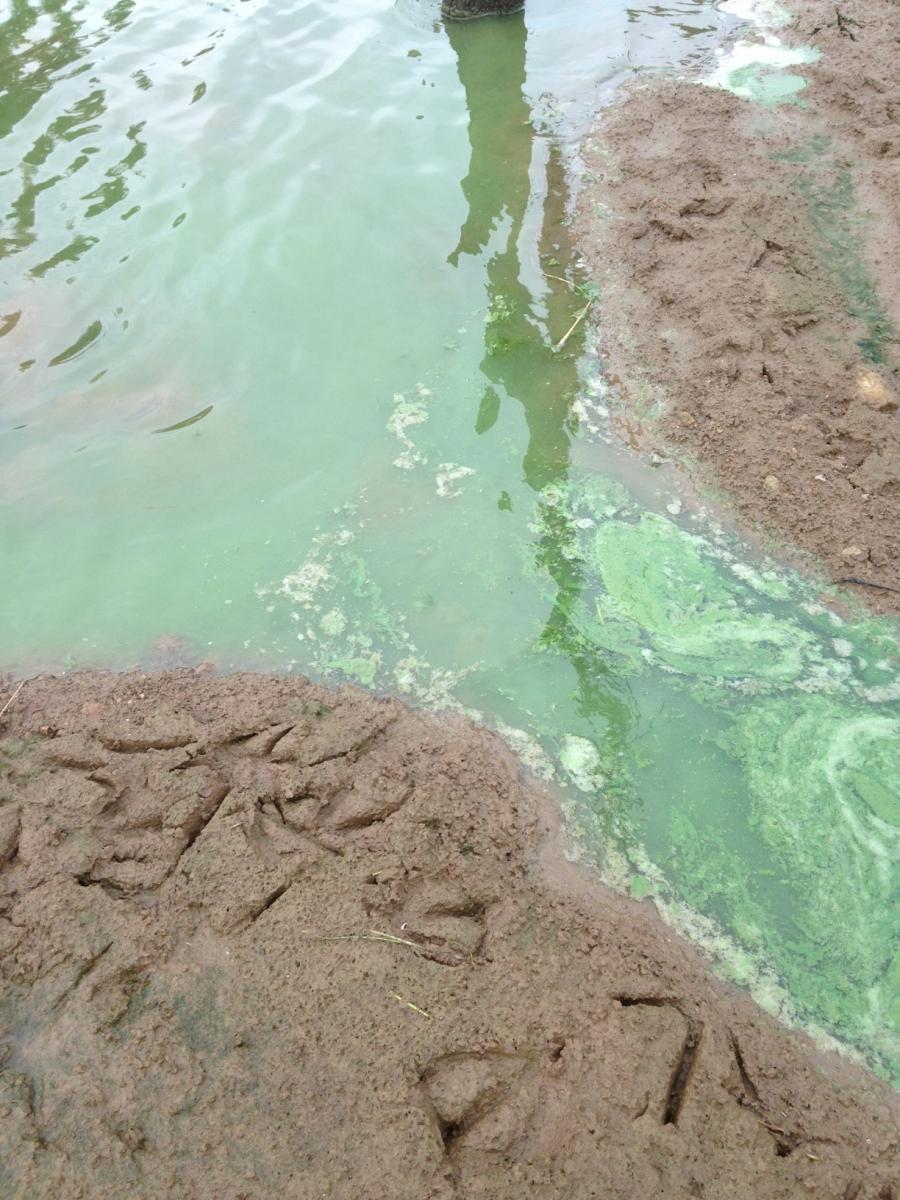Harmful Algal Blooms - Are My Cattle in Danger?
Harmful Algal Blooms - Are My Cattle in Danger?
Water is the most critical factor in the diet of cattle and during hot and dry weather, it is especially important to monitor water quality. Harmful algal blooms (HABs) can reduce water quality and intake, and are potentially toxic to livestock. Although blooms can occur at any time of year, they happen most often in the warmer months between June and September. In freshwater, the majority of HABs are caused by cyanobacteria or blue-green algae. Blue-green algae are simple plants that exist naturally in water and wet environments. They prefer warm, stagnant, nutrient-rich water and are found most often in ponds, lakes, and slow moving rivers. Farm ponds contaminated with fertilizer run-off or direct manure and urine contamination are prime places for algae to thrive. During periods of hot and dry conditions, rapid proliferation of blue‐green algae may result in a “bloom”, which is a build-up of algae that creates a green, blue-green, white, or brown coloring on the surface of the water, sometimes occurring as mats or scum. It may look like a floating layer of paint. Windy conditions can concentrate algal blooms along water edges, increasing the risk for livestock to ingest algae when they drink.

Pond in Anderson County-Photo courtesy of Dr. Jeff Lehmkuhler, University of Kentucky
Of the more than 2000 species of blue-green algae identified, at least 80 are known to produce toxins that can affect animals and humans. The most common species of blue-green algae in North America associated with poisoning are Anabaena, Aphanizomenon, Oscillatoria, and Microcystis. Microcystis is the most common bloom-forming genus, and is often toxic. Microcystis blooms are a greenish, thick, paint-like (sometimes granular) material that accumulates along shores. Scums that dry on the shores of lakes may contain high concentrations of microcystin toxin for several months, allowing toxins to dissolve in the water even when the cells are no longer alive or after a recently collapsed bloom. Species of the genus Anabaena form slimy summer blooms on the surface of lakes and reservoirs. Oscillatoria form long, slender, straight filaments that usually remain separate but form dense surface scums. Its presence may be revealed by a strong earthy odor and the filaments are easily detected visually in a water sample.
Environmental factors such as water temperature, sunlight, water pH, and nutrient concentration affect when toxins will be produced. Cyanobacterial toxins (“cyanotoxins”) can affect the liver and nervous system and have been implicated in human and animal illness and death in over fifty countries worldwide, including at least 35 U.S. States. Human poisoning associated with cyanotoxins most commonly occur after exposure through drinking contaminated water or water recreational activities. Exposure can result in a number of symptoms in people including skin rashes; eye, nose, mouth, or throat irritation; allergic reactions; headache and malaise; and gastrointestinal upset including abdominal pain, nausea, vomiting, and diarrhea. In humans, it is believed the toxin must be ingested in order to be fatal. Animals that consume the affected water may die suddenly, or suffer from weakness, staggering, or photosensitization depending on the specific toxin and amount ingested.
Blue-green algae toxins are released when algal cells are damaged and die in the water (for instance, after water is treated with an algaecide such as copper sulfate), or when ingested water reaches the animal’s digestive tract and algal cells are disrupted, releasing the toxins. Some algae produce potent neurotoxins (toxins that affect the nervous system) that cause signs in animals such as muscle tremors, difficulty breathing, seizures, profuse slobbering, diarrhea, and rapid death within minutes to hours. Other algae can produce hepatotoxins (toxins that affect the liver) that can cause death quickly or a more delayed onset of death after signs of liver failure develop. Photosensitization, a skin condition causing white (light or non-pigmented) areas of skin to peel, can occur in animals that survive the acute stages of liver damage. Pets and livestock are most at risk when drinking contaminated water or cleaning algae from fur/hair coat. Most animals exposed to blue-green algae toxins die acutely and are often found dead very near the water source. The only treatment is supportive care and medications to alleviate the symptoms.
If algal blooms are noticed, testing of water samples with algae is recommended because not all blooms produce toxins. Many algal blooms in Kentucky are composed of harmless green algae which may look like underwater moss, stringy mats or floating scum. It is impossible to tell visually if a water source contains blue-green algae or not, or to determine which specific species are present without laboratory identification. The UK Veterinary Diagnostic Laboratory accepts water samples and forwards them to referral laboratories for blue-green algae identification and the presence of toxins Anatoxin-A, and Microcystin. For protection of human health from exposure to the algae and any of the toxins, many states use the World Health Organization (WHO) guideline level of 100,000 algal cells/ml water or a microcystin toxin level of 6 parts per billion (ppb) for a Recreation Advisory and beaches will be closed if the microcystin toxin level reaches 20 ppb. In Kentucky, cyanobacteria have been found previously to be growing in Green River Lake, Taylorsville Lake, Barren River Lake, Nolin Reservoir and Rough River Lake at levels that prompted a recreational advisory. Unfortunately, testing water for an actual toxin is problematic because toxins are not uniformly distributed in the water source, testing can be quite expensive (for example, California charges $175 per water sample to identify anatoxin-a), and there are many blue-green algae toxins for which no diagnostic tests exist. To be safe, always assume that a blue-green algal bloom has the potential to be toxic.
Steps to Prevent Blue-Green Algae Poisoning
Livestock and pets:
- Always assume that a blue-green algal bloom is toxic.
- Provide constant access to clean, clear fresh water and fence off or otherwise prevent access to stagnant, scum-covered ponds. Fencing off natural water sources and providing alternative water sources is the best option.
- Do not allow animals to contaminate the water with feces and urine. Prevent fertilizer or manure runoff from entering water sources. Phosphorous is particularly important in fueling cyanobacteria growth.
- If a water source is treated with an algaecide such as copper sulfate, prevent animal access to the water for at least a week or longer to allow degradation of any released toxins in the water. It is best to wait until the pond is no longer stagnant before allowing animals to drink from it.
- Creating and maintaining natural buffers such as trees and shrubs between farmland, housing developments and waterways can help filter out excess nitrogen and phosphorus before they reach the water.
Humans:
- Do not swim or allow children or pets to swim in water with scum layers or blooms. Avoid jet-skiing, windsurfing, tubing, or water-skiing over scum or blooms.
- Do not use untreated water for drinking, cleaning food, or washing camping gear.
- Do not boil water to remove blue-green algae; this will not remove algal toxins.
- If you come into contact with a bloom, wash your skin and hair thoroughly. If your animal comes into contact with a bloom, wash it thoroughly with clean water to prevent blue-green algae ingestion when your animal licks itself.
- Do not eat fish or shellfish caught or harvested in a bloom area.
- Respect any water body closures by public health authorities.

Grant County Anabaena bloom. Photo Courtesy of Mark Martin at Kentucky Division of Water.

Livestock pond in Scott County: Planktothrix-Anabaena bloom. Photo courtesy of Mark Martin at KY Division of Water.
Author: Michelle Arnold, DVM-Ruminant Extension Veterinarian (UKVDL)
Contributors: Dr. Cynthia Gaskill (UK Veterinary Diagnostic Laboratory), Dr. Amanda Gumbert, Dr. Steve Higgins, Kylie Schmidt (University of Kentucky Cooperative Extension)
